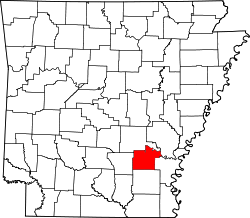Gould, Arkansas | |
|---|---|
 Gould water tower | |
 Location in Lincoln County, Arkansas | |
| Coordinates: 33°59′14″N91°33′51″W / 33.98722°N 91.56417°W | |
| Country | United States |
| State | Arkansas |
| County | Lincoln |
| Area | |
• Total | 1.55 sq mi (4.02 km2) |
| • Land | 1.55 sq mi (4.02 km2) |
| • Water | 0.00 sq mi (0.00 km2) |
| Elevation | 167 ft (51 m) |
| Population (2020) | |
• Total | 663 |
• Estimate (2024) | 626 |
| • Density | 427.47/sq mi (165.06/km2) |
| Time zone | UTC-6 (Central (CST)) |
| • Summer (DST) | UTC-5 (CDT) |
| ZIP code | 71643 |
| Area code | 870 |
| FIPS code | 05-27730 |
| GNIS feature ID | 2403718 [2] |
Gould is a city in Lincoln County, Arkansas, United States. Its population was 663 at the 2020 census, down from 837 at the 2010 census. [3] It is included in the Pine Bluff, Arkansas Metropolitan Statistical Area. Gould is a farming community. [4] It was named after the American railroad magnate Jay Gould. [5]
